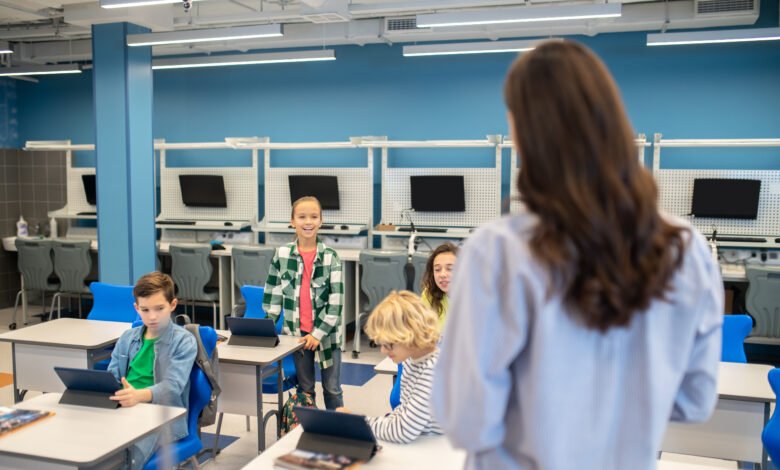
In the dynamic landscape of education, smart classrooms have emerged as a transformative force, reshaping traditional learning environments and enhancing the academic experience for students. The integration of technology in education has given rise to the concept of smart classrooms, where interactive tools, digital resources, and connectivity converge to create a more engaging and efficient learning space. As we delve into the intricacies of these futuristic learning environments, exam takers find themselves at the forefront of this educational evolution. This article explores the multifaceted advantages and considerations surrounding smart classrooms, unraveling the impact they have on the learning journey of individuals giving exams.
The Advantages of Smart Classrooms:
Smart classrooms stand at the forefront of a technological revolution in education, ushering in a new era of dynamic and interactive learning environments. With the integration of cutting-edge technology, these classrooms offer a myriad of advantages that transcend traditional teaching methods. The shift towards smart classrooms is driven by a commitment to enhance the educational experience, providing students and educators with innovative tools to engage with content, collaborate seamlessly, and personalize the learning journey. From interactive whiteboards to adaptive learning platforms, the advantages of smart classrooms extend beyond conventional boundaries, shaping a more inclusive, connected, and forward-thinking approach to education. This article explores the multifaceted benefits that smart classrooms bring to the forefront, outlining the transformative impact they have on the educational landscape.
Interactive Learning Opportunities:
Smart classrooms foster interactive learning experiences, providing individuals giving exams with dynamic tools that transcend traditional teaching methods. Interactive whiteboards, collaborative platforms, and multimedia resources engage students actively, promoting a deeper understanding of the subject matter.
Personalized Learning Pathways:
Tailoring education to individual needs, smart classrooms utilize technology to create personalized learning pathways. Adaptive learning platforms and data analytics empower individuals giving exams to progress at their own pace, ensuring a customized approach to mastering academic content.
Enhanced Connectivity and Collaboration:
Connectivity lies at the heart of smart classrooms, enabling seamless collaboration among those who are giving exams. Virtual classrooms, online discussions, and shared resources facilitate collaborative learning, breaking down geographical barriers and fostering a globalized educational experience.
Considerations and Challenges:
In the ever-evolving landscape of education, the integration of innovative technologies brings forth a plethora of opportunities and advancements. However, this transformative journey is not without its considerations and challenges. As educational institutions embrace digital transformations, it becomes imperative to critically assess the implications and navigate the potential hurdles that may arise. Considerations span a spectrum from ensuring equitable access to technology to safeguarding data privacy and security. Simultaneously, challenges emerge in the form of adapting teaching methodologies, addressing the digital divide, and fostering a robust framework for teacher training. This article delves into the multifaceted realm of considerations and challenges in education’s technological evolution, shedding light on the nuances that must be carefully navigated to ensure a seamless and equitable integration of technology in learning environments.
Digital Divide Concerns:
While smart classrooms offer advanced learning opportunities, concerns about the digital divide persist. Those who have to appear in exams from economically disadvantaged backgrounds may face challenges accessing the required technology, potentially exacerbating educational inequalities.
Security and Privacy Considerations:
The integration of technology in education raises concerns about data security and privacy. Those who want to give exams engage with online platforms may be susceptible to potential risks, necessitating robust measures to safeguard sensitive information.
Teacher Training and Adaptation:
The successful implementation of smart classrooms hinges on educators’ ability to adapt to and harness the potential of new technologies. Adequate training for teachers is crucial to ensure a seamless transition and effective utilization of smart classroom tools.
Navigating Smart Classrooms:
Utilizing Digital Resources for Exam Preparation:
Individuals can leverage the wealth of digital resources available in smart classrooms for effective exam preparation. Interactive study materials, online practice tests, and collaborative platforms enhance the learning experience and readiness for assessments.
Participating in Virtual Learning Communities:
Smart classrooms extend beyond physical spaces, offering individuals the opportunity to participate in virtual learning communities. Online forums, discussion boards, and collaborative projects enable students to connect with peers, share insights, and seek support.
Adopting Adaptive Learning Strategies:
Individuals can benefit from adaptive learning strategies facilitated by smart classrooms. The ability to tailor learning experiences based on individual progress and understanding allows students to focus on areas that require additional attention, optimizing exam preparation.
Final Thoughts
As we navigate the landscape of smart classrooms, it becomes evident that the integration of technology in education is not merely a trend but a transformative paradigm that significantly impacts individuals giving exams. The advantages of interactive learning, personalized pathways, and enhanced connectivity are undeniable, yet challenges such as the digital divide and security considerations must be addressed. For individuals, embracing the opportunities presented by smart classrooms requires active participation, utilization of digital resources, and a proactive approach to adapting to the evolving educational landscape. The journey through smart classrooms is a collaborative effort, where educators, institutions, and individuals collectively contribute to shaping a future where technology enhances, rather than hinders, the pursuit of academic excellence.
Frequently Asked Questions
What defines a smart classroom and how does it differ from traditional classrooms?
A smart classroom integrates advanced technology and interactive tools to create an innovative learning environment. It differs from traditional classrooms by leveraging digital resources, connectivity, and interactive features to enhance the overall learning experience.
How do smart classrooms benefit students in terms of engagement and learning outcomes?
Smart classrooms engage students through interactive whiteboards, multimedia resources, and collaborative platforms. These elements contribute to increased student engagement, personalized learning pathways, and improved understanding of academic content, ultimately leading to enhanced learning outcomes.
What challenges may arise with the implementation of smart classrooms, and how can they be addressed?
Challenges in smart classrooms may include the digital divide, security concerns, and the need for teacher training. Addressing these challenges involves implementing measures to bridge the digital gap, ensuring data security and privacy, and providing comprehensive training programs for educators.
How can students maximize the benefits of smart classrooms for exam preparation and collaborative learning?
To leverage the benefits of smart classrooms, students can utilize digital resources for exam preparation, actively participate in virtual learning communities, and adopt adaptive learning strategies. Engaging with online forums, discussion boards, and collaborative projects enhances the learning experience and fosters collaborative learning.



